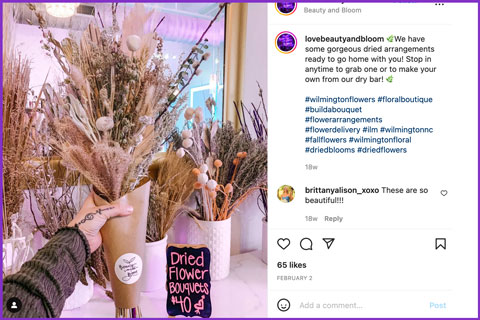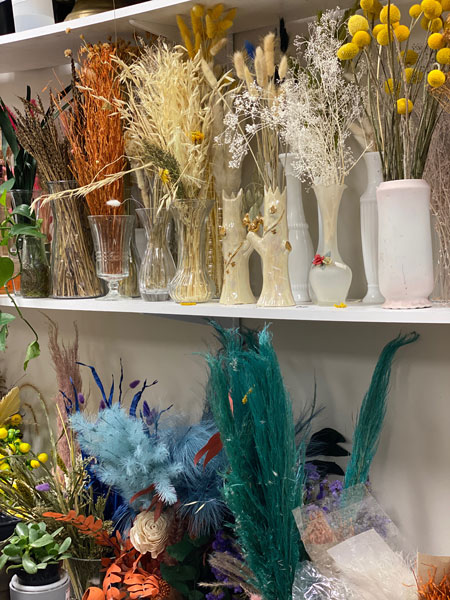7/1/2022
Trendspotting: Dry is the New Fresh
Katie Elzer-Peters

There are two in the bathroom of the new Tapas restaurant. The hippie coffee house has at least five on the shelves behind the counter. Plant Delights lined their entry drive with pots full of them for their winter open house. And there’s a DIY bar at one of our high-end hair and skin care salons. Yep, dried botanicals in every color, shape and form are everywhere.
As Jen Polanz said, “Now that you’ve told me about it, I’m seeing dried floral all over.” Now you’ll notice, too. Take pictures and collect ideas for incorporating this trend into your business of selling live plants. It’s a natural progression. There are no dried plants without live plants.
Pictured: Dried botanicals play a huge role in the business (and Instagram feed) of Beauty & Bloom Salon in Wilmington, North Carolina.
Another reason to be excited? The dried flower charge is being led by Gen Z co-horts. The aspects of upcycling, recycling and extended utility involved with dried botanical creations are a central part of their core beliefs. Who knew the way to younger hearts and minds was “after the bloom”?
The Why of Dry
Liz Maker knew. They’re the owner of “After the Bloom” (@after_the_bloom), a dried floral and art supplier in Wilmington, North Carolina. I talked with Liz and several other business owners about how and why they went dry to give you some ideas for your own businesses.
Liz says, “I worked for various farms, gardens and landscaping companies since I was a teenager. Over the years, I naturally started gravitating toward floral work. The variety that can be found in flowers is so expansive and I find that very comforting! Being able to preserve some of that beauty is a joy.”
“I am a huge advocate of horticultural therapy,” they continue. “Using your hands to build arrangements can be a relaxing practice when you spend some time just playing around. You don’t need to have any experience to get started—just an admiration for a bloom!”
Katie Mabry van Dieren, founder of Strawberry Swing in Kansas City (@strawberryswingkc) and owner of Shop Local Kansas City (@shoplocalkansascity), reached out to florists during the spring of 2020 inviting them to sell flowers at the markets she organized.
“They were thrilled because all of their weddings had been canceled,” she said.
 Market customers were also thrilled. As weddings picked up in 2021 and florists got busy again, Katie decided to handle the flower offerings herself.
Market customers were also thrilled. As weddings picked up in 2021 and florists got busy again, Katie decided to handle the flower offerings herself.
Pictured: These vases are thrifted, which falls in line with the Gen Z love of all things recycled and upcycled.
When she opened her retail shop, the dried flower wall/ bar started as décor. “It was a way to add lots of color without stocking expensive merchandise,” she said.
She thrifts vases and containers for both the dried botanicals selection and her fresh flower arrangements. That’s just another way to participate in the recycle and upcycle trend. Eventually, the dried florals became as popular as the fresh. She offers both for delivery as a pilot program with DoorDash.
Lindsay Webb and Shelly Shi opened Beauty and Bloom Salon (@lovebeautyandbloom) in May 2019. Lindsay and Shelly made flower crowns to take to markets in Wilmington, a side hustle in addition to their day jobs as hair stylists. When they decided to join forces and open their own salon, it was a given to them that floral design would be an integral part of it.
After celebrating their third birthday in June, the two are already in need of expansion. And they’ve had to put the brakes on some of their floral endeavors — “No more full weddings, only bouquets, flower crowns and wearable flowers”—because they simply don’t have the capacity. They still take flowers to markets as time permits.
“Going to markets is a great way to build community. Markets are a great way to market the salon,” Lindsay said. “At the past few markets we’ve sold more dried florals than fresh! The dried trend is definitely gaining steam.”
Does this sound familiar? Maybe why most of us got into the garden business? They, and we (at least most of the time), have a huge love of plants and flowers. The dried flower enthusiasts—they’re just like us! Let’s bring them into the fold.
Post-Pandemic Progression of Garden Retail
Anyone can play with dried florals, work with them, enjoy them, with no fear that they’re going to kill them. With many people resuming travel, family activities and working in-office, what are they gonna do with their 50 houseplants? If they still want some aspect of nature in their house—BINGO! Dried flowers!
The dried trend also neatly illustrates the reality of retail after COVID. Ben Futa, owner of BOTANY (@botanyorbust) in South Bend, Indiana, and I talked at length about the many micro businesses that opened during the pandemic. Those new businesses “bloomed” and grew at pop-up markets, as mobile retailers in converted VW vans, old school buses and as delivery services. They formed within their communities, to serve their communities, and they’ve grown because of community support. Their customers expect to be part of a community with the business owners and expect these businesses to be involved in their communities.
The businesses start by supporting each other. Many that have grown into storefronts carry merchandise from their fellow micro shops. They almost all give back to their communities and make a point of including that in their messaging.
“I get a lot of positive feedback in regard to the donations After The Bloom makes to the trans and gender-expansive community,” Liz says. (It’s why I’ve included the Instagram handles of the businesses interviewed. They’re case studies in how to build community through business.)
Why it Matters
If any of this seems unusual, take it from the mouth of a second generation horticulturist and floral innovator, Erin Weston. She’s the owner of Weston Farms in Garner, North Carolina, which sells fresh magnolia stems retail and wholesale. She says, “Your profits are in your compost heap.”
While Erin sells fresh stems, a core part of her marketing is teaching people how to dry the magnolia wreaths and swags, and encouraging them to enjoy the plant material as it dries instead of discarding it.
If you’ve ever had to give a customer permission to compost an aging poinsettia or a cyclamen that’s stopped blooming, you’ll love dried botanicals.
“Hang it upside down and let it dry, then stick it in a vase!” can become your new mantra. That’s what Lindsay and Shelly do.
“We dry everything. Anything we don’t use fresh for weddings or that doesn’t sell to customers, we dry,” said Lindsay. Then they use it to set up a spectacular DIY dry bouquet bar for customers to make their own arrangements.
Turning trash into treasure, a new direction for building community, ways to invite people who love flowers, but are pressed for time or scared of growing them into the fold? There are endless reasons to go dry.
How to Go Dry
Just like with traditional living garden merchandise and gardening activities, there are tons of entry points to dried botanicals.
Types of dried botanical merchandise:
• Small bud vase arrangements
• Large statement pieces
• Posies or a little cash-and-carry bouquets
• Add-ons for gift wrap
• Pressed flowers for shadowboxes and art projects
• Flower crowns and hair pieces
• Individual stems (in the same way you’d offer faux flowers)
Ways to offer dried product to customers:
• Self-hosted make-it, take-it workshops
• As cash and carry, pre-assembled arrangements
• As DIY dry bars
• Inviting local makers and micro businesses to host pop-ups
Ways to collaborate with dried floral micro businesses:
• Invite them to hold workshops or pop-up dry bars
• Encourage them to stop by and harvest flowers, plumes or stems at the end of the season
• Feature them on your social media or in your email marketing as part of community building
• Invite your customers to harvest and bring dried items to local micro businesses at specific days and times (to keep foreign plant material out of your shop, set up a tent outside your front entry for drop-off)
More dried botanical tips:
• Group similar shapes together—twigs in one container, pampas grass in another; that helps keep them from sticking together
• Shake (or use a hair dryer, says Shelly, the hair stylist), to blow the bits out of grass flowers before adding to the bar
• Make time to tidy any self-serve areas weekly at a minimum
• Give customers instructions for drying their own fresh arrangements or flower crowns
• “Experiment with dried materials and primarily use those that don’t shed,” said Erin. GP
Katie Elzer-Peters is the owner of The Garden of Words, LLC, a green-industry digital marketing agency. Contact her at Katie@thegardenofwords.com.